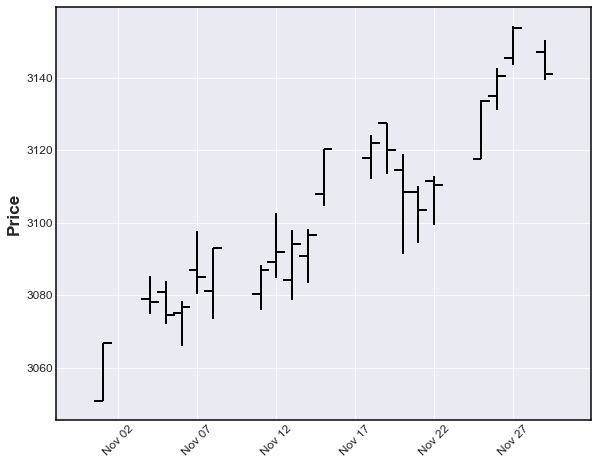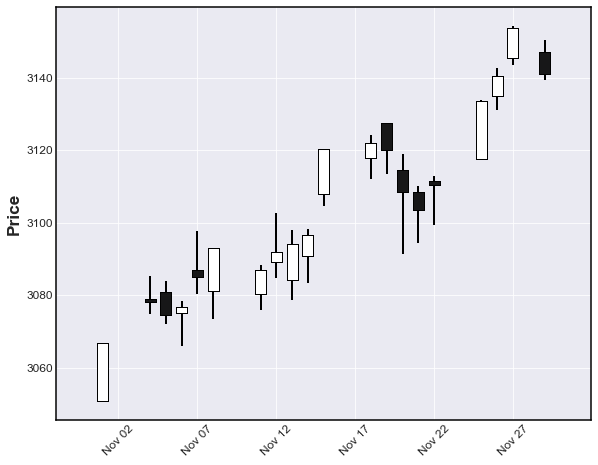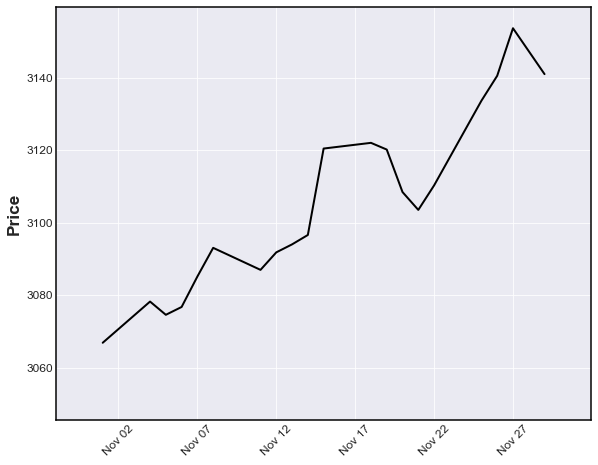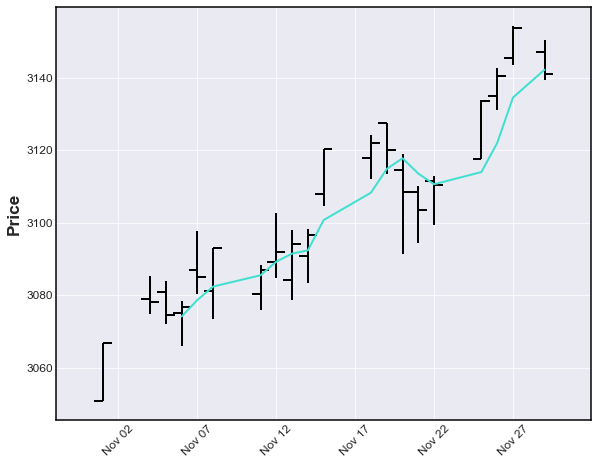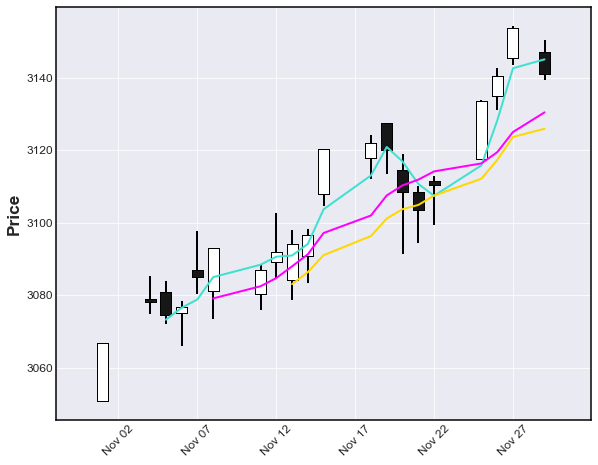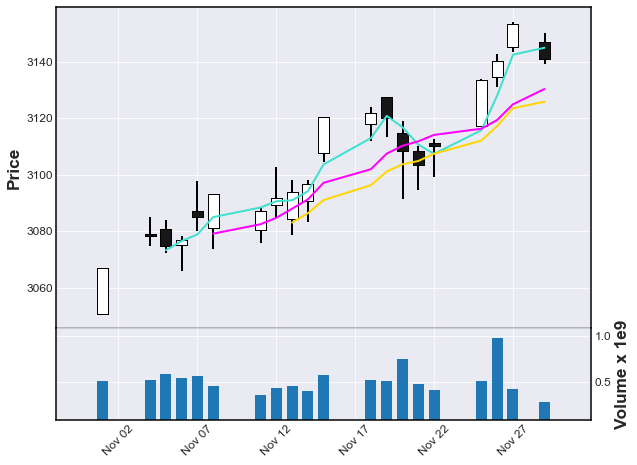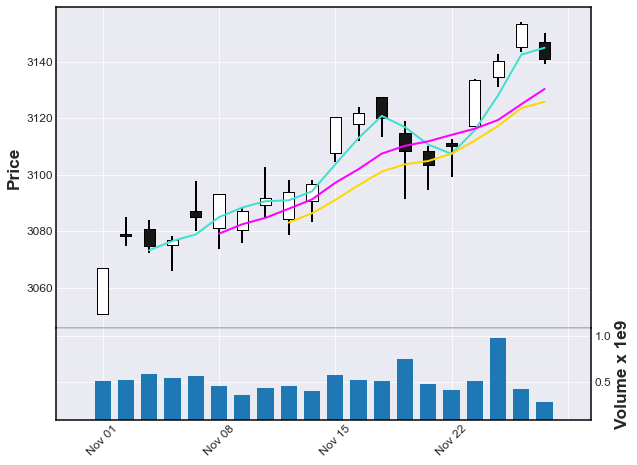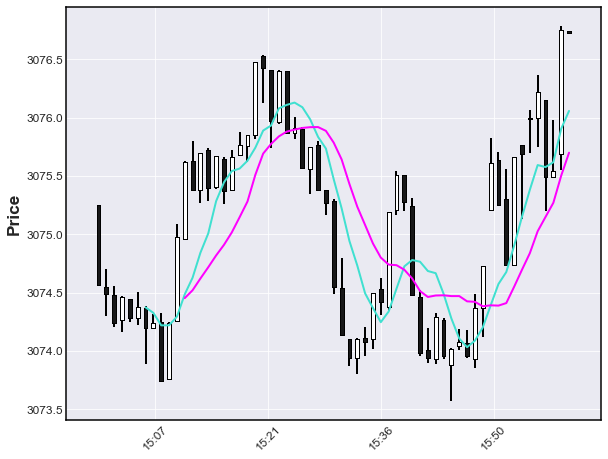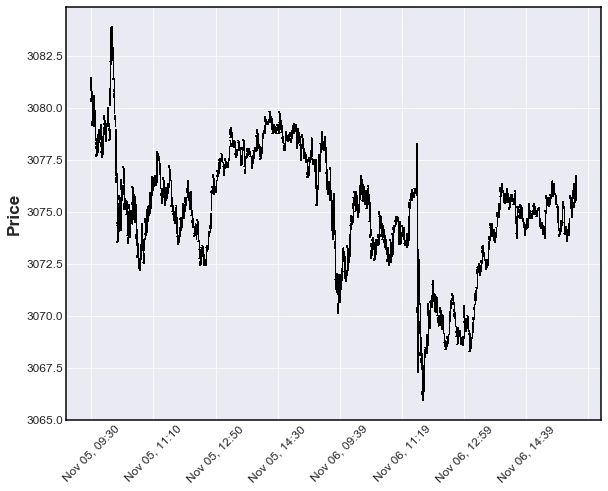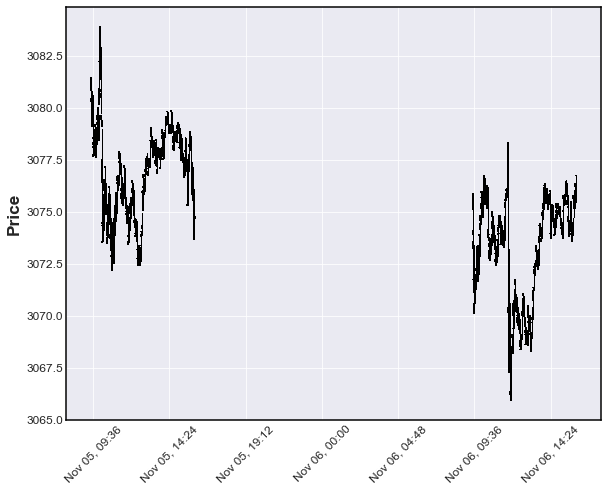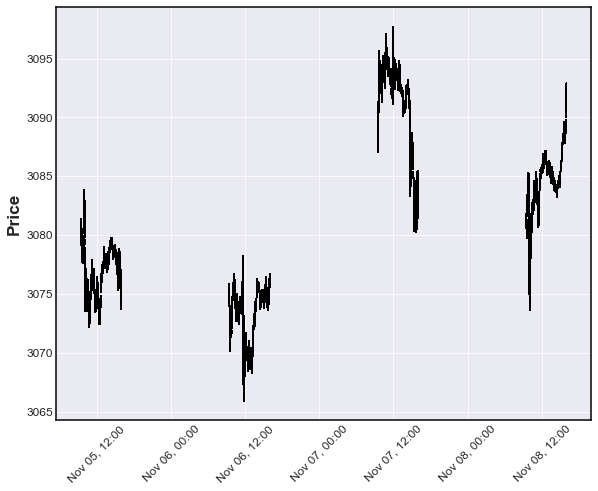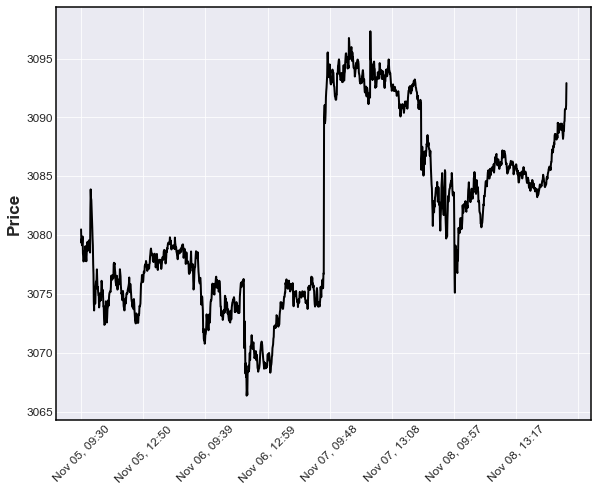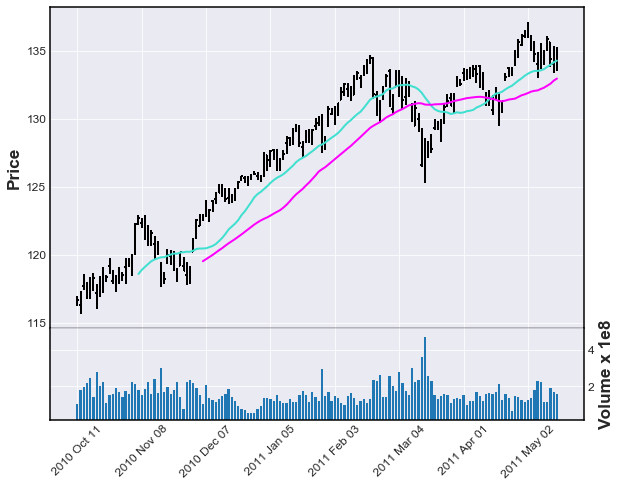Utilities for the visualization, and visual analysis, of financial data
Project description
mplfinance
matplotlib utilities for the visualization, and visual analysis, of financial data
Installation
pip install mplfinance
- mplfinance requires matplotlib and pandas
Contents
- The New API
- Basic Usage
- Adding Custom Data to Ohlcv Plots
- Customizing the Appearance of Plots (presently in development)
- Technical Studies (presently in development)
- Latest Release Info
- Some Background History About This Package
- Old API Availability
The New API
This repository, matplotlib/mplfinance, contains a new matplotlib finance API that makes it easier to create financial plots. It interfaces nicely with Pandas DataFrames.
More importantly, the new API automatically does the extra matplotlib work that the user previously had to do "manually" with the old API. (The old API is still available within this package; see below).
The conventional way to import the new API is as follows:
import mplfinance as mpf
The most common usage is then to call
mpf.plot(data)
where data is a Pandas DataFrame object containing Open, High, Low and Close data, with a Pandas DatetimeIndex.
Details on how to call the new API can be found below under Basic Usage, as well as in the jupyter notebooks in the examples folder.
I am very interested to hear from you regarding what you think of the new mplfinance, plus any suggestions you may have for improvement. You can reach me at dgoldfarb.github@gmail.com
Basic Usage
Start with a Pandas DataFrame containing OHLC data. For example,
import pandas as pd
daily = pd.read_csv('examples/data/SP500_NOV2019_Hist.csv',index_col=0,parse_dates=True)
daily.index.name = 'Date'
daily.shape
daily.head(3)
daily.tail(3)
(20, 5)
| Open | High | Low | Close | Volume | |
|---|---|---|---|---|---|
| Date | |||||
| 2019-11-01 | 3050.72 | 3066.95 | 3050.72 | 3066.91 | 510301237 |
| 2019-11-04 | 3078.96 | 3085.20 | 3074.87 | 3078.27 | 524848878 |
| 2019-11-05 | 3080.80 | 3083.95 | 3072.15 | 3074.62 | 585634570 |
...
| Open | High | Low | Close | Volume | |
|---|---|---|---|---|---|
| Date | |||||
| 2019-11-26 | 3134.85 | 3142.69 | 3131.00 | 3140.52 | 986041660 |
| 2019-11-27 | 3145.49 | 3154.26 | 3143.41 | 3153.63 | 421853938 |
| 2019-11-29 | 3147.18 | 3150.30 | 3139.34 | 3140.98 | 286602291 |
After importing mplfinance, plotting OHLC data is as simple as calling mpf.plot() on the dataframe
import mplfinance as mpf
mpf.plot(daily)
The default plot type, as you can see above, is 'ohlc'. Other plot types can be specified with the keyword argument type, for example, type='candle' or type='line'
mpf.plot(daily,type='candle')
mpf.plot(daily,type='line')
We can also plot moving averages with the mav keyword
- use a scalar for a single moving average
- use a tuple or list of integers for multiple moving averages
mpf.plot(daily,type='ohlc',mav=4)
mpf.plot(daily,type='candle',mav=(3,6,9))
We can also display Volume
mpf.plot(daily,type='candle',mav=(3,6,9),volume=True)
Notice, in the above chart, there are gaps along the x-coordinate corresponding to days on which there was no trading.
- Many people like to see these gaps so that they can tell, with a quick glance, where the weekends and holidays fall.
- For example, in the above chart you can see a gap at Thursday, November 28th for the U.S. Thanksgiving holiday.
- Gaps along the x-axis can be eliminated with the
no_xgapskeyword
mpf.plot(daily,type='candle',mav=(3,6,9),volume=True,no_xgaps=True)
We can also plot intraday data:
intraday = pd.read_csv('examples/data/SP500_NOV2019_IDay.csv',index_col=0,parse_dates=True)
intraday = intraday.drop('Volume',axis=1) # Volume is zero anyway for this intraday data set
intraday.index.name = 'Date'
intraday.shape
intraday.head(3)
intraday.tail(3)
(1563, 4)
| Open | Close | High | Low | |
|---|---|---|---|---|
| Date | ||||
| 2019-11-05 09:30:00 | 3080.80 | 3080.49 | 3081.47 | 3080.30 |
| 2019-11-05 09:31:00 | 3080.33 | 3079.36 | 3080.33 | 3079.15 |
| 2019-11-05 09:32:00 | 3079.43 | 3079.68 | 3080.46 | 3079.43 |
...
| Open | Close | High | Low | |
|---|---|---|---|---|
| Date | ||||
| 2019-11-08 15:57:00 | 3090.73 | 3090.70 | 3091.02 | 3090.52 |
| 2019-11-08 15:58:00 | 3090.73 | 3091.04 | 3091.13 | 3090.58 |
| 2019-11-08 15:59:00 | 3091.16 | 3092.91 | 3092.91 | 3090.96 |
The above dataframe contains Open,High,Low,Close data at 1 minute intervervals for the S&P 500 stock index for November 5, 6, 7 and 8, 2019. Let's look at the last hour of trading on November 6th, with a 7 minute and 12 minute moving average.
iday = intraday.loc['2019-11-06 15:00':'2019-11-06 16:00',:]
mpf.plot(iday,type='candle',mav=(7,12))
The "time-interpretation" of the mav integers depends on the frequency of the data, because the mav integers are number of data points used in the Moving Average. Notice above that for intraday data the x-axis automatically displays TIME instead of date. Below we see that if the intraday data spans two (or more) trading days then two things happen:
- The x-axis displays BOTH TIME and DATE
no-xgapsdefaults toTrueFOR INTRADAY DATA INVOLVING TWO OR MORE TRADING DAYS
iday = intraday.loc['2019-11-05':'2019-11-06',:]
mpf.plot(iday,type='candle')
In the plot below, we see what would happen if no_xgaps did NOT default to True for intraday data involving two or more days.
mpf.plot(iday,type='candle',no_xgaps=False)
Below: 4 days of intraday data with no_xgaps=False
mpf.plot(intraday,type='ohlc',no_xgaps=False) # 4 day of intraday with no_xgaps=False
Below: 4 days of intraday data with no_xgaps defaulted to True for intraday data spanning more than one day.
mpf.plot(intraday,type='line') # intraday spanning more than one day defaults to no_xgaps=True
Below: Daily data spanning more than a year automatically adds the YEAR to the DATE format
df = pd.read_csv('examples/data/yahoofinance-SPY-20080101-20180101.csv',index_col=0,parse_dates=True)
df.shape
df.head(3)
df.tail(3)
(2519, 6)
| Open | High | Low | Close | Adj Close | Volume | |
|---|---|---|---|---|---|---|
| Date | ||||||
| 2007-12-31 | 147.100006 | 147.610001 | 146.059998 | 146.210007 | 118.624741 | 108126800 |
| 2008-01-02 | 146.529999 | 146.990005 | 143.880005 | 144.929993 | 117.586205 | 204935600 |
| 2008-01-03 | 144.910004 | 145.490005 | 144.070007 | 144.860001 | 117.529449 | 125133300 |
...
| Open | High | Low | Close | Adj Close | Volume | |
|---|---|---|---|---|---|---|
| Date | ||||||
| 2017-12-27 | 267.380005 | 267.730011 | 267.010010 | 267.320007 | 267.320007 | 57751000 |
| 2017-12-28 | 267.890015 | 267.920013 | 267.450012 | 267.869995 | 267.869995 | 45116100 |
| 2017-12-29 | 268.529999 | 268.549988 | 266.640015 | 266.859985 | 266.859985 | 96007400 |
mpf.plot(df[700:850],type='bars',volume=True,no_xgaps=True,mav=(20,40))
For more examples of using mplfinance, please see the jupyter notebooks in the examples directory.
Release Notes
| Version | Description | Release Date |
|---|---|---|
| 0.12.x | Ability plot arbitrary user data (in addition to basic OHLCV data). - both line and scatter plots available. - optionally plot on either the "main" or "lower" (aka "volume") axis. |
2020-01-09 |
| 0.11.x | Basic Plotting from Pandas DataFrame of OHLC bars and candlesticks. - optional display of volume - optional display of (up to 3 different) moving averages. - old API still available by importing from "mplfinance/original_flavor" |
2019-12-20 |
| 0.10.x | Old mpl-finance API set up as its own package (i.e. removed from the matplotlib package). |
2016-09-08 |
Some History
My name is Daniel Goldfarb. In November 2019, I became the maintainer of matplotlib/mpl-finance. That module is being deprecated in favor of the current matplotlib/mplfinance. The old mpl-finance consisted of code extracted from the deprecated matplotlib.finance module along with a few examples of usage. It has been mostly un-maintained for the past three years.
It is my intention to archive the matplotlib/mpl-finance repository soon, and direct everyone to matplotlib/mplfinance. The main reason for the rename is to avoid confusion with the hyphen and the underscore: As it was, mpl-finance was installed with the hyphen, but imported with an underscore mpl_finance. Going forward it will be a simple matter of both installing and importing mplfinance.
old API availability
With this new mplfinance package installed, in addition to the new API, users can still access the old API (at least for the next several months) by changing their import statments
from:
from mpl_finance import <method>
to:
from mplfinance.original_flavor import <method>
where <method> indicates the method you want to import, for example:
from mplfinance.original_flavor import candlestick_ohlc
Project details
Release history Release notifications | RSS feed
Download files
Download the file for your platform. If you're not sure which to choose, learn more about installing packages.
Source Distribution
Built Distribution
File details
Details for the file mplfinance-0.12.0a1.tar.gz.
File metadata
- Download URL: mplfinance-0.12.0a1.tar.gz
- Upload date:
- Size: 18.8 kB
- Tags: Source
- Uploaded using Trusted Publishing? No
- Uploaded via: twine/3.0.0 pkginfo/1.5.0.1 requests/2.21.0 setuptools/41.6.0 requests-toolbelt/0.9.1 tqdm/4.31.1 CPython/3.6.8
File hashes
| Algorithm | Hash digest | |
|---|---|---|
| SHA256 |
19c57361c306a7661c0f63b584c2028cf70e2b7cba2ec82a6fe3228626183aef
|
|
| MD5 |
cd4eeeb8e18acdd93e25d707084abac1
|
|
| BLAKE2b-256 |
cf9aa02362c870464988b4c7b18ff0e4cfa6666d9c8584b197b8a391df331361
|
File details
Details for the file mplfinance-0.12.0a1-py3-none-any.whl.
File metadata
- Download URL: mplfinance-0.12.0a1-py3-none-any.whl
- Upload date:
- Size: 20.8 kB
- Tags: Python 3
- Uploaded using Trusted Publishing? No
- Uploaded via: twine/3.0.0 pkginfo/1.5.0.1 requests/2.21.0 setuptools/41.6.0 requests-toolbelt/0.9.1 tqdm/4.31.1 CPython/3.6.8
File hashes
| Algorithm | Hash digest | |
|---|---|---|
| SHA256 |
ac9c1ecabf6eb73e77dd81a61244dfb995b012d3b683f403e4e85e947d0aef06
|
|
| MD5 |
01cd1698fb1810093bfe26a7b86bd672
|
|
| BLAKE2b-256 |
69e994641253054dd6812c300f9cf8b1fccba8010646932ca2e9524fdab8e05f
|



